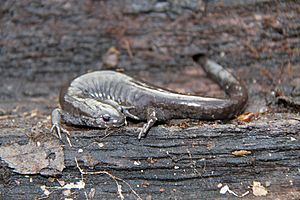Small-mouth salamander facts for kids
Quick facts for kids Small-mouth salamander |
|
|---|---|
 |
|
| Conservation status | |
| Scientific classification | |
| Genus: |
Ambystoma
|
| Species: |
texanum
|
| Synonyms | |
|
Salamandra texana |
|
The small-mouth salamander (scientific name: Ambystoma texanum) is a type of mole salamander. These cool creatures live in the central United States. You can find them from the Great Lakes area down to Texas. They also live east to Tennessee. There's even a group of them in Canada, on Pelee Island. People sometimes call them the Texas salamander or the narrow-mouthed salamander.
Contents
What Does It Look Like?
Small-mouth salamanders usually grow to be about 4.5 to 7 inches long. They are often black or dark brown. They have light grey or silvery spots or blotches. Their head is quite small compared to their body. They also have a long tail. Male salamanders are usually smaller than the females. Their bellies are black, often with tiny flecks. They have 14 to 15 grooves on their sides.
Life and Behavior
Small-mouth salamanders are nocturnal, meaning they are active at night. They often live underground. They like damp places close to water.
Reproduction and Life Cycle
Breeding happens in the spring. Groups of salamanders gather near the water. A female can lay up to 700 eggs! She attaches them in small groups of up to 30 eggs. These egg clumps stick to rocks or plants underwater.
Baby salamanders, called larvae, hatch at about 0.5 inches long. They change into adult salamanders in May or June. By then, they are about 1.6 inches long.
What Do They Eat?
Small-mouth salamanders eat insects, slugs, and earthworms.
How They Protect Themselves
If a small-mouth salamander feels scared, it will lift its tail. It then waves its tail back and forth. They are shy creatures. They often share their breeding ponds with larger spotted salamanders and marbled salamanders.
Where Do They Live?
Small-mouth salamanders live in damp pine woodlands. They also live in deciduous forest areas and tallgrass prairies. You can find them in farming areas too. They often live near temporary ponds and along streams. Their home range stretches from western West Virginia south to the Gulf of Mexico. It goes west to Kansas, Oklahoma, and Texas.
Conservation Status
The only known population of small-mouth salamanders in Canada is on Pelee Island. This island is in Lake Erie. The COSEWIC has listed this population as endangered. This means they are at risk of disappearing.


